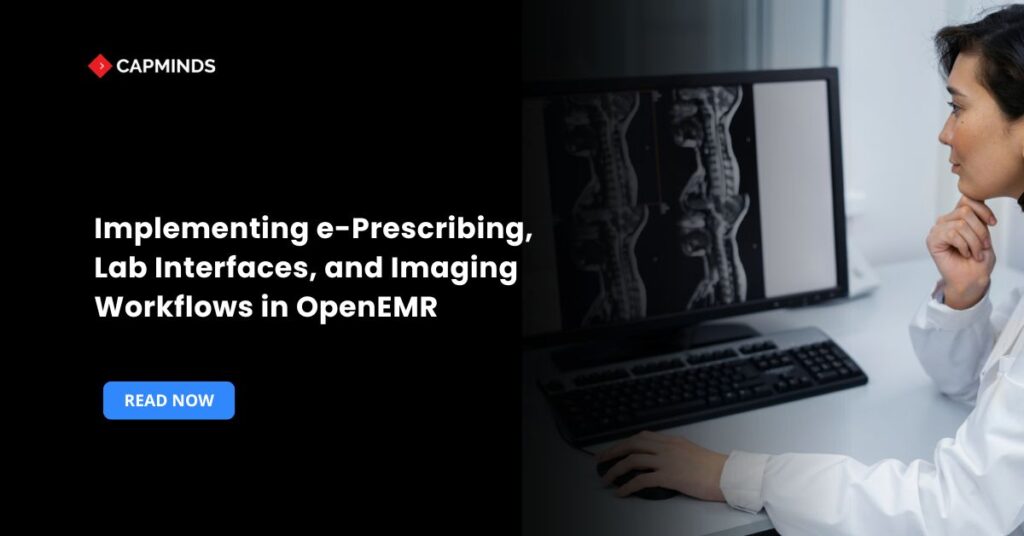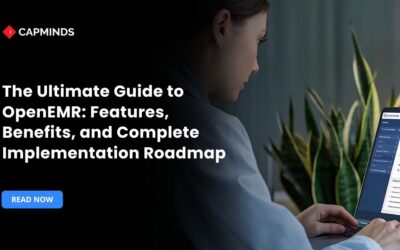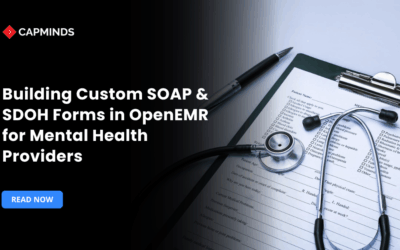Implementing e-Prescribing, Lab Interfaces, and Imaging Workflows in OpenEMR
Electronic processes are no longer optional; they are required for providing efficient, coordinated, and high-quality patient care. OpenEMR is one of the most popular open-source EHR systems, providing healthcare organizations with an effective platform for streamlining operations.
Three key components that improve OpenEMR’s capabilities are e-prescribing, lab interfaces, and imaging workflows. Implementing these features can improve healthcare operations, decrease mistakes, and increase overall efficiency.
In this blog, you’ll learn about each feature, the methods for deployment, and practical considerations to assist healthcare providers.
Streamlining Medication Management with e-Prescribing
E-Prescribing saves time and reduces errors due to handwriting or transcribing problems. Integrating e-Prescribing into OpenEMR allows clinicians to electronically submit prescriptions directly to pharmacies, increasing both efficiency and patient safety.
Steps for Implementing e-Prescribing in OpenEMR
Implementing e-prescribing requires careful planning and cooperation across clinical, IT, and administrative teams.
- Choose an e-Prescription Vendor – Select a certified e-prescribing system that works with OpenEMR, such as Weno Exchange.
- Register and Credential Providers – Make sure all prescribing clinicians are enrolled and validated with the eRx program.
- Configure System Settings – Enable the e-Prescribing module by updating OpenEMR’s global settings.
After Integration, Suppliers can
- Utilize real-time insurance formulary checks to generate and distribute prescriptions electronically.
- To avoid drug interactions and duplications, access the patient’s prescription history.
- Use limited medicine e-prescribing tools to cut down on prescription fraud.
- By implementing e-Prescribing, clinics may ensure safer medication management while significantly improving workflow efficiency.
Integrating Lab Interfaces for Seamless Results
Laboratory testing is a vital part of patient treatment. Manually maintaining lab orders and results causes inefficiencies, more effort, and chance of mistakes. Implementing lab interfaces in OpenEMR enables providers to electronically order tests and get results from inside the system, reducing the need for paper faxes or manual data entry.
Implementing lab interfaces in OpenEMR
To develop lab interfaces, healthcare practitioners often leverage HL7 protocols to facilitate bidirectional communication between OpenEMR and external labs.
The Key Steps to follow
- Select a Lab Partner – Collaborate with a laboratory that understands electronic interface and has worked with OpenEMR.
- Set up HL7 Integration – To guarantee safe HL7 communication between OpenEMR and the lab’s system, collaborate with the IT personnel.
- Test and Validate – To ensure that test ordering, result transfer, and report formatting are accurate, do a thorough test.
The Lab Interface Allows Healthcare Providers
- Electronically order tests and obtain results without leaving the OpenEMR environment.
- Automatically enter lab findings into patient charts and encounter notes.
- Create alerts for crucial numbers to reduce the chance of missing unexpected data.
Related: Transforming Radiology with Seamless Integration of OpenEMR and DICOM
Imaging Workflows with Integrated PACS and DICOM
Why Imaging Integration Matters
Diagnostic imaging and radiology are essential to healthcare; however, many medical practices find it difficult to efficiently manage imaging operations. Providers may obtain imaging data and reports instantly by integrating OpenEMR with imaging systems like PACS and DICOM standards.
An integrated imaging process allows for faster diagnosis, more efficient communication, and improved cooperation amongst care teams.
Key Implementation Steps
- Choose an open-source or commercial PACS system that supports OpenEMR and DICOM standards.
- Activate and set up the imaging module in OpenEMR to communicate with the chosen PACS.
- Create role-based access restrictions to guarantee that only authorized users may see, upload, and analyze imaging studies.
Using Image Integration, Users Can
- View photographs and radiological reports right in the patient’s electronic chart.
- Reduce the time between picture acquisition and diagnosis.
- Improve cooperation with centralized picture storage and retrieval.
This integrated imaging approach improves both clinical efficiency and patient care quality.
Best Practices for Successful Implementation
OpenEMR’s implementation of these advanced features requires a thoughtful approach that takes people and technology into account.
1. Engage Stakeholders Early
Involve physicians, administration staff, and IT teams in the planning process to gain feedback and resolve problems. Conduct workflow mapping sessions to identify problem areas and customize solutions accordingly.
2. Prioritize Training and Change Management
Provide hands-on training sessions for providers and support workers to help them become more confident in utilizing new features. Maintain continuing assistance with super users, cheat sheets, and help desk tools.
3. Ensure Compliance and Security
When handling electronic prescriptions, lab data, or imaging files, follow HIPAA, HITECH, and CMS requirements. Implement strong security features like two-factor authentication and data encryption.

The Advantages of a Fully Integrated OpenEMR System
- Improved clinical decision-making is facilitated by automated medication checks, real-time lab data, and speedier imaging interpretations.
- Doctors may spend less time on administrative tasks and more time with patients if they reduce manual labor.
- Reducing errors and streamlining processes leads to lower overhead costs and higher output.
- Paperwork, reporting, and regulatory compliance are all made simpler by digital processes.
The combination of these integrated characteristics enables providers to provide higher-quality treatment while retaining operational efficiency.
Power Your Clinical Efficiency with CapMinds’ OpenEMR Integration Solutions
At CapMinds, we help healthcare providers modernize their operations through seamless OpenEMR integrations.
From e-prescribing and lab connectivity to imaging workflows, we deliver end-to-end digital health tech solutions that boost efficiency, accuracy, and compliance.
Our OpenEMR services include:
- e-Prescribing Integration – Real-time medication management with EPCS support
- Lab Interface Setup – Automated test orders and result imports
- Imaging Workflow Integration – Instant access to radiology images and reports
- HIPAA-Compliant Hosting – Secure, scalable cloud or on-premises infrastructure
- Training & Support – Full team onboarding, SOP creation, and technical assistance
Transform your EHR into a powerful, patient-centered platform. Partner with CapMinds today.




